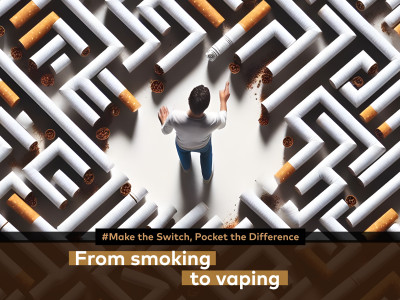“Concern about the health risks associated with [vape] devices has grown,” they write. “Most studies to date indicate that e-cigarettes are less harmful than tobacco cigarettes, but much uncertainty remains regarding the absolute health risks of e-cigarette use, especially with respect to long-term effects and the risks of inhaling flavor components and thermal decomposition products. Furthermore, the technical design of e-cigarettes and their operation continues to evolve rapidly, demanding continuous adaptation of research methods.”
The team are concerned that studies have focused on users and not bystanders suffering from so-called secondhand vape. They must have missed the 2015 study by Marco and Grimalt [link] and one earlier this year by Martín, Peñín-Ibáñez, Gonzálvez, Santos-Delgado, and Ureña [link].
Public Health England states that vape has been tarred with a ‘second-hand’ brush simply because it looks like smoke. “Unlike cigarettes,” says Martin Dockrell, “there is no side-stream vapour emitted by an e-cigarette into the atmosphere, just the exhaled aerosol. PHE’s latest evidence review found that to date, there have been no identified health risks of passive vaping to bystanders.”
The team concluded:
- The levels of tobacco-specific nitrosamines in exhaled vapor are high enough that an elevated risk of cancer could not be excluded. The risks can be avoided altogether by enforcing that e-liquids may not contain detectable amounts of TSNAs
- Our study indicates that health risks to bystanders exist. This result can be taken into consideration in policies for vaping in public spaces, together with other considerations such as the potential risk of increasing social renormalisation of ‘smoking’
- Acute health effects experienced by e-cigarette users have been observed that might be attributable to specific flavor ingredients. Hungary has recently opted to ban the use of flavors in e-liquids.
The UK E-Cigarette Research Forum highlights a number of limitations in their work:
- The estimates of chemical concentrations in second-hand vapour were not directly measured in car or office scenarios. Many estimates were calculated by extrapolating harm found in animal studies and others used harm estimates from studies of similar compounds rather than of the chemical itself. All harm estimates had no specific effect size, therefore the actual harm to bystanders from chemicals in second-hand vapour cannot be determined.
- There was no comparison to tobacco smoke and no tests of significance were carried out for the harm estimates. We cannot determine whether these predicted effects were significant and a result of e-cigarette vapour exposure or the relative harm of vapour compared to cigarette smoke.
- The sample size was very small, the number of puffs were pre-specified, only one session per person was measured and the volume of exhaled air varied considerably between participants. Therefore, the estimated average volume and chemical concentrations of vapour in each scenario may not be reliable or reflect real-world vaping behaviour.
- This study did not test differences in chemical concentration by specific devices or e-liquids. Only a small sample of e-cigarettes were included that are not necessarily representative of the range of devices and e-liquids available.
ASH UK stated in its recent briefing paper: “There is no evidence of harm to health from ‘second hand vaping’ and the risks are likely to be very low. The risk to users of inhaling e-cigarette vapour is low and the risk to those who breathe their exhaled vapour is even lower due to only exhaled aerosol being emitted.”
Resources:
- “The Health Risks of Electronic Cigarette Use to Bystanders” by Visser, Klerx , Cremers, Ramlal, Schwillens and Talhout – [link]
- “On the Passive Exposure to Nicotine from Traditional Cigarettes Versus e-Cigarettes” by Martín, Peñín-Ibáñez, Gonzálvez, Santos-Delgado, and Ureña- [link]
- “A rapid method for the chromatographic analysis of volatile organic compounds in exhaled breath of tobacco cigarette and electronic cigarette smokers” by Marco and Grimalt - [link]
Dave Cross
Journalist at POTVDave is a freelance writer; with articles on music, motorbikes, football, pop-science, vaping and tobacco harm reduction in Sounds, Melody Maker, UBG, AWoL, Bike, When Saturday Comes, Vape News Magazine, and syndicated across the Johnston Press group. He was published in an anthology of “Greatest Football Writing”, but still believes this was a mistake. Dave contributes sketches to comedy shows and used to co-host a radio sketch show. He’s worked with numerous vape companies to develop content for their websites.
Join the discussion
Trading Standards Welcomes Clarity
The Chartered Trading Standards Institute says it welcomes the “clarity and action from government to tackle youth vaping” with the plan to ban disposable vapes and related announcements
UKVIA Writes To Sunak
The UKVIA has sent a letter to Prime Minister Rishi Sunak to 'express profound dismay and disappointment' that the government has decided to proceed with a ban on disposable vapes
FOI Shows Disposables Ban Folly
389 Freedom of Information requests made by leading online retailer Vape Club and one by the BBC demonstrate the extent to which a ban on disposable vapes is a complete act of folly
ASH UK’s Coordinated Comment
Action on Smoking and Health has coordinated a series of responses to the Governments proposals to include interested parties












